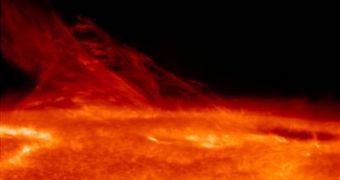The solar wind represents an emission from the Sun in the form of electrically charged particles, mostly hydrogen, which fills the void space all around the star. Scientists say that these deadly waves of radiation blowing through the whole solar system at speeds as high as 1.6 million kilometers per hour are triggered by powerful magnetic activity on the Sun's surface.
Though the mechanism that determines the solar winds remained mostly a mystery since it was predicted over half a century ago, scientists operating the Japanese Hinode satellite placed on Earth's orbit say that they are driven by so-called Alfen waves, representing strong magnetic waves originating from the plasma of the sun's corona, while converting part of the energy on the surface of the star into solar wind. Alfen waves have been named after the Swedish physicist Hannes Alfen, a Nobel prize winner in 1970 for his work that predicted the existence of such waves.
Data extracted from the Hinode satellite showed that the solar wind is triggered through two distinct mechanisms. The first one involves rapid variations in the shape of the magnetic field, which generates the Alfen waves along the length of the magnetic field causing the acceleration of the electrically charged plasma and immediate ejection into space. The second mechanism, takes place in the layer between the solar surface and the corona, also known as chromosphere, which as the Hinode satellite shows, is filled with Alfen waves that leak from time to time into the superior layer with enough force to trigger the solar wind.
Due to technology and instrument limitations the observation of the Alfen waves has been impossible. However, the Hinode space satellite is equipped with three key instruments, a large optical telescope with which the satellite makes observations of the Sun from Earth's orbit, an ultraviolet spectrograph and a second telescope operating in the X-ray spectrum to make continuous observations of the Sun.
The existence of solar winds was confirmed in the 1970s and though we cannot feel their action on the Earth's atmosphere directly, due to the fact that our planet protects us with the help of a magnetic field that creates a surrounding bubble around which the winds flow, the indirect effects can be seen in the northern lights or the aurora borealis. Powerful solar winds can also disrupt satellite activity and could knock out electric power grids and communications on the Earth's surface.
The Hinode program is led by Japan's Aerospace Exploration Agency, in cooperation with NASA and the European Space Agency.

 14 DAY TRIAL //
14 DAY TRIAL //